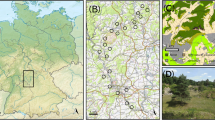Abstract
Until now very few biocenological studies have been carried out on dragonflies. This paper describes the various functions of vegetation for Odonata, especially in habitat selection.
It is shown that the two endangered species, Orthetrum coerulescens and Ceriagrion tenellum, due to their dependence on specific abiotic factors, strongly prefer particular plant communities. In selecting suitable breeding habitats, vegetation probably serves as a releasing signal (‘proximate factor’). In contrast, the two species hardly show any clear preference for any of the parameters of the community structure. For the example of C. tenellum the highly selective choice of plant stands and communities is presented in detail. Its ecoscheme may be described as consisting of three main parts, with the vegetation playing a decisive role.
Methodological questions are also discussed. In many dragonfly species the breeding habitats can be described by the plant communities, as well as additional parameters. In conclusion, a step by step procedure for biocenological studies on dragnoflies is proposed.
Similar content being viewed by others
References
Buchwald, R. 1983. Ökologische Untersuchungen an Libellen im westlichen Bodenseeraum. In: Der Mindelsee bei Radolfzell, pp. 339–637. Monographieeines Naturschutzgebietes auf dem Bodanrück. Natur- und Landschaftsschutzgebiete Bad.-Württ. 11. Karlsruhe.
Buchwald R. 1989. Die Bedeutung der Vegetation für die Habitatbindung einiger Libellenarten der Quellmoore und Fließgewässer. Phytocoenologia 17(3): 307–448.
Buchwald R. & Schmidt B. 1990. Der Kleine Blaupfeil (Orthetrum coerulescens, Odonata) in Südbaden—Spezielle Untersuchungen zu ökologischen Ansprüchen, Populationsdynamik und Gefährdung. Mitt. bad. Landesver. Naturkde u. Naturschutz N.F. 15(1): 109–144.
Buchwald, R. 1991. Libellenfauna und Vegetation—eine Zwischenbilanz biozönologischer Untersuchungen. In: Kratochwil, A. (ed.). Verh. Ges. Ökol. Beih. 2 Freiburg.
Demarmels J. & Schiess H. 1977. Zum Vorkommen der Zwerglibelle Nehalennia speciosa (Charp. 1840) in der Schweiz. Viertelj. schr. Naturf. Ges. Zürich 122: 339–348.
Kratochwil A. 1987. Zoologische Untersuchungen auf pflanzensoziologischem Raster — Methoden, Probleme und Beispiele biozönologischer Forschung. Tuexenia 7: 13–51.
Oberdorfer E. (ed.) 1977. Süddeutsche Pflanzengesellschaften. Aufl., Teil I. G. Fischer; Stuttgart, New York.
Osche G. 1986. Ökoschema. In: Lexikon der Biologie, Bd., pp. 225. Herder; Freiburg, Basel, Wien.
Passarge H. 1981. Gedanken zur Biozönoseforschung. Tuexenia 1: 243–247.
Rabeler W. 1937. Die planmäßige Untersuchung der Soziologie, Ökologie und Geographie der heimischen Tiere. Mitt. Flor.-soz. Arbeitsgem. Nieders. 3: 236–247.
Rabeler W. 1957. Die Tiergemeinschaft eines Eichen-Birkenwaldes im nordwestdeutschen Altmoränengebiet. Mitt. Flor.-Soz. Arbeitsgem. N.F. 6/7: 297–319.
Rabeler W. 1960. Die Artenbestände der Regenwürmer in Laubwald-Biozönosen (Querco-Fagetea) des oberen und mittleren Wesergebietes. Mitt. Flor.-Soz. Arbeitsgem. N.F. 8: 333–337.
Rabeler W. 1965. Die Pflanzengesellschaften ais Grundlage für die landbiozönotische Forschung. In: Tüxen R. (ed.). Biosoziologie, pp. 43–57. Ber. Internat. Sympos. IVV Stolzenau/W. 1960. Junk, Den Haag.
Sternberg, K. 1990. Autökologie von 6 Libellenarten der Moore und Hochmoore des Schwarzwaldes und Ursachen ihrer Moorbindung. Diss. Fak. f. Biol., Univ. Freiburg i. Br.
Tüxen R. (ed.) 1965. Biosoziologie. Ber. Internat. Sympos. IVV Stolzenau/W. 1960. Junk, Den Haag.
Tüxen R. (ed.) 1977. Vegetation und Fauna. Ber. Internat. Sympos. IVV Rinteln 1976. J. Cramer, Vaduz.
Wildermuth H. 1986. Zur Habitatwahl und zur Verbreitung von Somatochlora arctica (Zetterstedt) in der Schweiz (Anisoptera: Corduliidae). Odonatologica 15(2): 185–202.
Wilmanns O. 1987. Zur Verbindung von Pflanzensoziologie und Zoologie in der Biozönologie. Tuexenia 7: 3–12.
Author information
Authors and Affiliations
Rights and permissions
About this article
Cite this article
Buchwald, R. Vegetation and dragonfly fauna — characteristics and examples of biocenological field studies. Vegetatio 101, 99–107 (1992). https://doi.org/10.1007/BF00033195
Accepted:
Issue Date:
DOI: https://doi.org/10.1007/BF00033195




